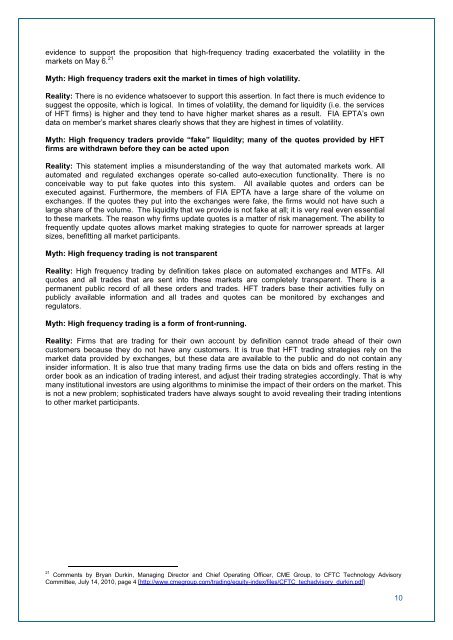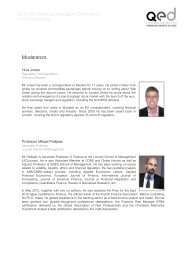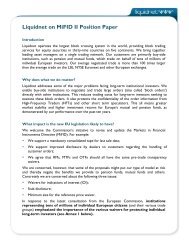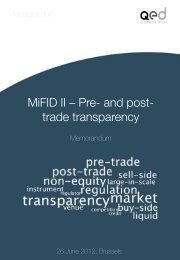FIA EPTA's position paper - Futures Industry Association
FIA EPTA's position paper - Futures Industry Association
FIA EPTA's position paper - Futures Industry Association
Create successful ePaper yourself
Turn your PDF publications into a flip-book with our unique Google optimized e-Paper software.
evidence to support the pro<strong>position</strong> that high-frequency trading exacerbated the volatility in the<br />
markets on May 6. 21<br />
Myth: High frequency traders exit the market in times of high volatility.<br />
Reality: There is no evidence whatsoever to support this assertion. In fact there is much evidence to<br />
suggest the opposite, which is logical. In times of volatility, the demand for liquidity (i.e. the services<br />
of HFT firms) is higher and they tend to have higher market shares as a result. <strong>FIA</strong> EPTA‟s own<br />
data on member‟s market shares clearly shows that they are highest in times of volatility.<br />
Myth: High frequency traders provide “fake” liquidity; many of the quotes provided by HFT<br />
firms are withdrawn before they can be acted upon<br />
Reality: This statement implies a misunderstanding of the way that automated markets work. All<br />
automated and regulated exchanges operate so-called auto-execution functionality. There is no<br />
conceivable way to put fake quotes into this system. All available quotes and orders can be<br />
executed against. Furthermore, the members of <strong>FIA</strong> EPTA have a large share of the volume on<br />
exchanges. If the quotes they put into the exchanges were fake, the firms would not have such a<br />
large share of the volume. The liquidity that we provide is not fake at all; it is very real even essential<br />
to these markets. The reason why firms update quotes is a matter of risk management. The ability to<br />
frequently update quotes allows market making strategies to quote for narrower spreads at larger<br />
sizes, benefitting all market participants.<br />
Myth: High frequency trading is not transparent<br />
Reality: High frequency trading by definition takes place on automated exchanges and MTFs. All<br />
quotes and all trades that are sent into these markets are completely transparent. There is a<br />
permanent public record of all these orders and trades. HFT traders base their activities fully on<br />
publicly available information and all trades and quotes can be monitored by exchanges and<br />
regulators.<br />
Myth: High frequency trading is a form of front-running.<br />
Reality: Firms that are trading for their own account by definition cannot trade ahead of their own<br />
customers because they do not have any customers. It is true that HFT trading strategies rely on the<br />
market data provided by exchanges, but these data are available to the public and do not contain any<br />
insider information. It is also true that many trading firms use the data on bids and offers resting in the<br />
order book as an indication of trading interest, and adjust their trading strategies accordingly. That is why<br />
many institutional investors are using algorithms to minimise the impact of their orders on the market. This<br />
is not a new problem; sophisticated traders have always sought to avoid revealing their trading intentions<br />
to other market participants.<br />
21 Comments by Bryan Durkin, Managing Director and Chief Operating Officer, CME Group, to CFTC Technology Advisory<br />
Committee, July 14, 2010, page 4 [http://www.cmegroup.com/trading/equity-index/files/CFTC_techadvisory_durkin.pdf]<br />
10










